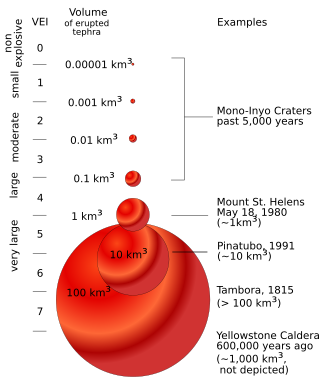
A volcano is a rupture in the crust of a planetary-mass object, such as Earth, that allows hot lava, volcanic ash, and gases to escape from a magma chamber below the surface.

The volcanic explosivity index (VEI) is a relative measure of the explosiveness of volcanic eruptions. It was devised by Christopher G. Newhall of the United States Geological Survey and Stephen Self in 1982.

Tolbachik is a volcanic complex on the Kamchatka Peninsula in the far east of Russia. It consists of two volcanoes, Plosky (flat) Tolbachik and Ostry (sharp) Tolbachik, which as the names suggest are respectively a flat-topped shield volcano and a peaked stratovolcano. As Ostry is the mountain's highest point, the entire mountain is often referred to as "Ostry Tolbachik", not to be confused with Ostry, a separate volcano to the north also on the Kamchatka Peninsula.
The Decade Volcanoes are 16 volcanoes identified by the International Association of Volcanology and Chemistry of the Earth's Interior (IAVCEI) as being worthy of particular study in light of their history of large, destructive eruptions and proximity to densely populated areas. The Decade Volcanoes project encourages studies and public-awareness activities at these volcanoes, with the aim of achieving a better understanding of the volcanoes and the dangers they present, and thus being able to reduce the severity of natural disasters.

Lava lakes are large volumes of molten lava, usually basaltic, contained in a volcanic vent, crater, or broad depression. The term is used to describe both lava lakes that are wholly or partly molten and those that are solidified.

The International Association of Volcanology and Chemistry of the Earth's Interior (IAVCEI) is a learned society that focuses on research in volcanology, efforts to mitigate volcanic disasters, and research into closely related disciplines, such as igneous geochemistry and petrology, geochronology, volcanogenic mineral deposits, and the physics of the generation and ascent of magmas in the upper mantle and crust. It is one of eight constituent associations of the International Union of Geodesy and Geophysics (IUGG).

The Smithsonian Institution's Global Volcanism Program (GVP) documents Earth's volcanoes and their eruptive history over the past 10,000 years. The mission of the GVP is to document, understand, and disseminate information about global volcanic activity.

The Bulletin of Volcanology is a peer reviewed scientific journal that is published ten times per year by Springer Science+Business Media. It is the official journal of the International Association of Volcanology and Chemistry of the Earth's Interior (IAVCEI). The focus of the journal is volcanoes, volcanic products, eruptive behavior, and volcanic hazards. The Executive Editor is Marie Edmonds.
Volcanoes of the World is a book that was published in three editions in 1981, 1994, and 2010 as a collaboration between volcanologists around the world, and the Smithsonian Institution's Global Volcanism Program (GVP).






